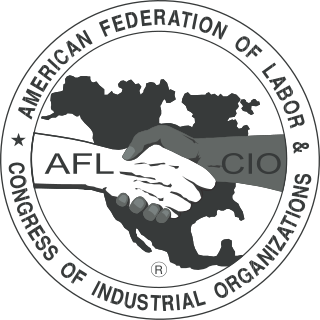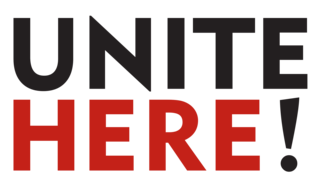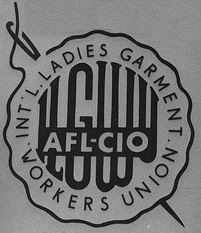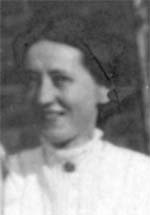
The American Federation of Labor and Congress of Industrial Organizations (AFL–CIO) is the largest federation of unions in the United States. It is made up of 60 national and international unions, together representing more than 12 million active and retired workers. The AFL–CIO engages in substantial political spending and activism, typically in support of progressive and pro-labor policies.
Collective bargaining is a process of negotiation between employers and a group of employees aimed at agreements to regulate working salaries, working conditions, benefits, and other aspects of workers' compensation and rights for workers. The interests of the employees are commonly presented by representatives of a trade union to which the employees belong. A collective agreement reached by these negotiations functions as a labour contract between an employer and one or more unions, and typically establishes terms regarding wage scales, working hours, training, health and safety, overtime, grievance mechanisms, and rights to participate in workplace or company affairs. Such agreements can also include 'productivity bargaining' in which workers agree to changes to working practices in return for higher pay or greater job security.
The United Food and Commercial Workers International Union (UFCW) is a labor union representing approximately 1.3 million workers in the United States and Canada in industries including retail; meatpacking, food processing and manufacturing; hospitality; agriculture; cannabis; chemical trades; security; textile, and health care. UFCW is affiliated with the Canadian Labour Congress (CLC) and the AFL–CIO; it disaffiliated from the AFL–CIO in 2005 but reaffiliated in 2013. UFCW is also affiliated to UNI Global Union and the IUF.

Service Employees International Union (SEIU) is a labor union representing almost 1.9 million workers in over 100 occupations in the United States and Canada. SEIU is focused on organizing workers in three sectors: healthcare, including hospital, home care and nursing home workers; public services ; and property services.

John Joseph Sweeney was an American labor leader who served as president of the AFL–CIO from 1995 to 2009.

UNITE HERE is a labor union in the United States and Canada with roughly 300,000 active members. The union's members work predominantly in the hotel, food service, laundry, warehouse, and casino gaming industries. The union was formed in 2004 by the merger of Union of Needletrades, Industrial, and Textile Employees (UNITE) and Hotel Employees and Restaurant Employees Union (HERE).
The Union of Needletrades, Industrial, and Textile Employees was a labor union in the United States. In 2004, UNITE merged with the Hotel Employees and Restaurant Employees Union (HERE) to form UNITE HERE.
The organizing model, as the term refers to trade unions, is a broad conception of how those organizations should recruit, operate, and advance the interests of their members, though the specific functions of the model are more detailed and are discussed at length below. It typically involves many full-time organizers, who work by building up confidence and strong networks and leaders within the workforce, and by confrontational campaigns involving large numbers of union members. The organizing model is strongly linked to social movement unionism and community unionism. The organizing model contributes to the discussion of how trade unions can reverse the trend of declining membership, which they are experiencing in most industrial nations, and how they can recapture some of the political power, which the labor movement has lost over the past century.

The International Ladies' Garment Workers' Union (ILGWU), whose members were employed in the women's clothing industry, was once one of the largest labor unions in the United States, one of the first U.S. unions to have a primarily female membership, and a key player in the labor history of the 1920s and 1930s. The union, generally referred to as the "ILGWU" or the "ILG", merged with the Amalgamated Clothing and Textile Workers Union in the 1990s to form the Union of Needletrades, Industrial and Textile Employees (UNITE). UNITE merged with the Hotel Employees and Restaurant Employees Union (HERE) in 2004 to create a new union known as UNITE HERE. The two unions that formed UNITE in 1995 represented 250,000 workers between them, down from the ILGWU's peak membership of 450,000 in 1969.
Amalgamated Clothing Workers of America (ACWA) was a United States labor union known for its support for "social unionism" and progressive political causes. Led by Sidney Hillman for its first thirty years, it helped found the Congress of Industrial Organizations. It merged with the Textile Workers Union of America (TWUA) in 1976 to form the Amalgamated Clothing and Textile Workers Union (ACTWU), which merged with the International Ladies' Garment Workers' Union in 1995 to create the Union of Needletrades, Industrial and Textile Employees (UNITE). UNITE merged in 2004 with the Hotel Employees and Restaurant Employees Union (HERE) in 2004 to create a new union known as UNITE HERE. After a bitter internal dispute in 2009, the majority of the UNITE side of the union, along with some of the disgruntled HERE locals left UNITE HERE, and formed a new union named Workers United, led by former UNITE president Bruce Raynor.

The Strategic Organizing Center (SOC), formerly known as the Change to Win Federation (CtW) is a coalition of North American labor unions originally formed in 2005 as an alternative to the AFL–CIO. The coalition is associated with strong advocacy of the organizing model. The coalition currently consists of International Brotherhood of Teamsters (IBT), Service Employees International Union (SEIU) and United Farm Workers (UFW). Communications Workers of America (CWA) is affiliated with both the SOC and AFL–CIO.
Justice for Janitors (JfJ) is a social movement organization that fights for the rights of janitors across the US and Canada. It was started on June 15, 1990, in response to the low wages and minimal health-care coverage that janitors received. Justice for Janitors includes more than 225,000 janitors in at least 29 cities in the United States and at least four cities in Canada. Members fight for better wages, better conditions, improved healthcare, and full-time opportunities.
The Federation of Hospital And University Employees is a coalition of labor unions in New Haven, Connecticut, United States, which represents thousands of workers at Yale University and Yale New Haven Hospital. The federation currently includes recognized unions UNITE HERE Locals 34 and 35, which represent university food service, maintenance, and custodial workers, and clerical and technical workers, respectively. UNITE HERE has also, for the last fifteen years, supported the organizing efforts of graduate student teachers and researchers in the Graduate Employees and Students Organization. Finally, the Federation also includes the 150 dietary workers at Yale New Haven Hospital who are members of Local 1199NE of the Service Employees International Union (SEIU). Since 1998, this union has conducted an organizing campaign of about 1,800 other blue-collar service workers at the hospital. On March 22, 2006, the union and hospital agreed to an agreement governing the conduct of both parties in a neutral election process by which hospital employees will be able to vote on whether to unionize.
Bruce S. Raynor is an American labor union executive. He is the former Executive Vice President of the Service Employees International Union (SEIU), former President of Workers United, former General President of UNITE HERE, a founding member of the Leadership Council of the Change to Win Federation (CTW), and a member of the Cornell University Board of Trustees. He was Chairman of several union-affiliated national pension and insurance funds. He was Chairman of the Board of Amalgamated Life Insurance Company, a union-affiliated insurance company established in 1943. Raynor also served as chairman of the Amalgamated Bank, the only union-owned bank in the U.S., with assets of more than $4.5 billion, and as former co-chair and current member of the Council of Institutional Investors, an organization of institutional investors that control $3 trillion in pension funds. Raynor is also President of The Sidney Hillman Foundation, a foundation that supports and rewards socially conscious journalism.

A union organizer is a specific type of trade union member or an appointed union official.
Richard Webster Cordtz was an American labor leader. From 1980 to 1995, he was the International Secretary-Treasurer of the Service Employees International Union under John Sweeney, and was president of the union himself from October 1995 to May 1996.

The American Federation of State, County and Municipal Employees (AFSCME) is the largest trade union of public employees in the United States. It represents 1.3 million public sector employees and retirees, including health care workers, corrections officers, sanitation workers, police officers, firefighters, and childcare providers. Founded in Madison, Wisconsin, in 1932, AFSCME is part of the AFL–CIO, one of the two main labor federations in the United States. AFSCME has had four presidents since its founding.
SEIU Member Activists for Reform Today (SMART) is a national organization of rank-and-file union members working for the democratic reform of the Service Employees International Union (SEIU). SEIU primarily represents workers in the public sector, healthcare industry, and property services. Today it is America's largest and fastest growing union with 2 million members, many of whom are minorities, immigrants, and women.

Mary Kay Henry is an American labor union activist who was elected International President of the Service Employees International Union (SEIU) on May 8, 2010. She is the first woman to lead the union. While serving with the union in California, she helped pioneer SEIU's use of card check agreements, non-traditional collective bargaining agreements, comprehensive campaigns, and system-wide health care organizing strategies. Henry was included on Time's 100 Most Influential People of 2020.








